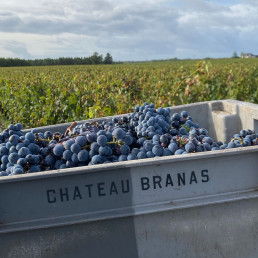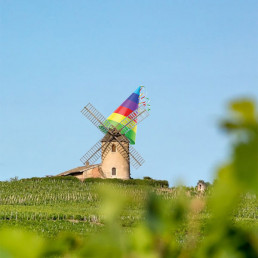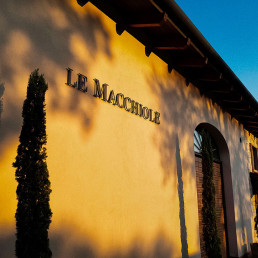Nectar of the Gods - Chateau d’Arche Sauternes
Downright Drink-me-Delicious!
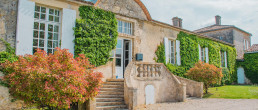
Luxurious, liquid gold in a bottle is always a rare treat. We all know that top-flight botrytized Bordeaux, in its head-spinning, ambrosial grandeur, is the vinous equivalent of riding in a Rolls Royce (with a chauffeur of course) and … it’s usually priced accordingly.
But not so of our latest Dhall & Nash offering – Chateau d’Arche. This rich, hedonistic, and outrageously complex nectar is here for the taking (in limited quantities), and happily for us all, it is approachably priced compared to similarly pedigreed Sauternes.
“d’Arche is clearly a very fine Sauternes yet remains under-estimated.”
Stephen Brook, The Complete Bordeaux: The Wines, The Chateaux, The People From the Vines to the Winery (4th Edition)
But one question perplexes us devotees of dessert wines. What is with this anti-sweet wine fashion? It is remarkably one of the world’s great wine mysteries as to why fewer and fewer people drink sweet and fortified wines. Yet, for those of us who are still smitten by “stickies”, we stubbornly adore these unctuous treats because they confirm exactly what great wine is all about – mind-blowingly beautiful balance. Supping them we experience that elusive tightrope of residual sugar, textural nirvana and refreshing acidity, interwoven with highly complex aromas and flavours. The finest examples will always leave the drinker wanting, yearning for another silken sip. And every bottle opened is in itself an event, a treasured experience that will live long in our memory.
Time to bring back sexy stickies – And D&N has! Welcome the esteemed producer of mystical nectar …Chateau d’Arche Sauternes AOC
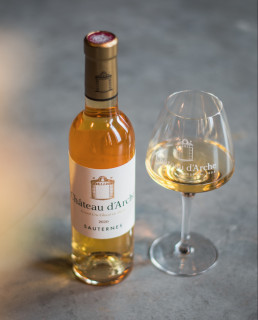
[ ] “the great wine of Château d´Arche is like its terroir: rare, timeless and vibrant”
Château d´Arche Website
Accolades

Chateau d’Arche
Sauternes 2017
“Opulent and rich, this densely textured wine is full in weight, with honey, sweet spice, rich peach and mango flavors. It is a fine wine, not for long-term aging and ready to drink from 2021.”
92 Points – Wine Enthusiast, Roger Voss
“Intense golden colour. Very elegant & pure nose, refined aroma reminiscent of candied orange peel, dried apricots, vanilla & mild spices, cloves & cinnamon, mango & passionfruit in the background. On the palate, well balanced with a wonderful tension, elegant acidity, balanced sweetness, excellent structure with great finesse & convincing length.”
94 Points – Markus Del Monego, Master of Wine

La Perle d’Arche
Sauternes 2022
- Made from select plots of 15-year-old vines within their 40ha of plantings, it offers exceptional value. Fruity on the nose. Quince aromas shine through, combined with lychee and green apple notes plus a touch of beeswax. Fruity and juicy on the palate with a good structure of acidity and a rounded style. This wine offers up crystallised citrus and green apple notes, with some lighter exotic fruit touches and a hint of orange.
Estate History
This fine estate has had a circuitous history to arrive at its celebrated status today. Chateau d’Arche is one of the older estates in the Sauternes appellation. In 1611, Etienne d’Arche 8th century generation, Knight and Lord of Arche, formed the branch of the family that settled in the Bordeaux region. A Doctor Regent of the University of Bordeaux and lawyer at the Parliament of Guyenne, he was the pioneer of the family to become passionate about the wine profession by buying an estate.
Over the years, like many Bordeaux wine producers, the estate has been divided and sold off at different times to a wide array of owners.
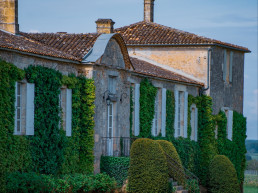
The French Revolution brought about a dissection of the property as it was seized, with several different families taking sections of the estate. At one point, it was known as Chateau d’Arche-Lafaurie-Peyraguey, due to the fact it shared owners with Chateau Lafaurie-Peyraguey.
In the 1855 Bordeaux Wine Official Classification, Château d’Arche was classified as a Second Cru Classé in the Sauternes appellation, an esteemed recognition for its outstanding sweet wines.
Further ownership changes ensued over the history of the property in the 19th and early 20th centuries. But by 1925 it was owned by a politician called Armand Bastit-St-Martin, who began rebuilding the property’s historic vineyards contributing to restoring the reputation of the winery.
In 1981, shortly before his death, he leased the property to Pierre Perromat, a former chairman of INAO (Institut Nacional des Appellations d’Origine). The property remained in the hands of the Basit-Martin family until 1996, when they sold it to an Irish family. By 2003 Perromat had turned over management of the property to his son-in-law Jérôme Cosson. Two years later, the estate was in the hands of private investors who have gone on to revitalize the winery and convert to organics.
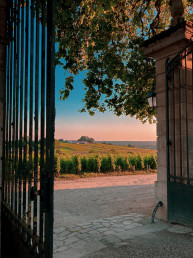
Recognized for its exceptional elegance and equality by the most famous wine critics in the world, the great wine of Château d´Arche is like its terroir: rare, timeless and vibrant
Terroir & Vines
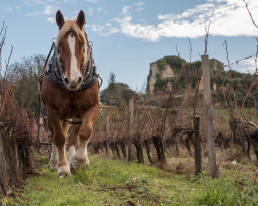
Located 40km south of Bordeaux, on the upper parts of the village of Sauternes, Château d’Arche is built on the summit of hills which overlook its prestigious neighbours, notably Châteaux d’Yquem and Guiraud.
This exceptional location, along with its varied soils, favours wines with very specific taste qualities: strength from the gravel soils, aromas from the clays and elegance from the alluvium. It is this unique terroir and aspect which imparts richness and complexity to the wines.
The Estate spans 56.5 hectares of vines across Sauternes and Bordeaux, at least 30 hectares of it surround the Chateau itself. Sitting close to the Ciron river, at a point in which the Garonne river intersects, creates a perfect microclimate with end of summer fog making optimal humidity for the Chateau d’Arche vines to develop Botrytis Cinerea – the Noble Rot – which dries the grapes to concentrate the sugars and noble flavours within.
The team at Chateau d’Arche champion the Semillon variety, which consists of 90% of their total plantings. Interestingly, Sémillon has a slightly low acidity, but it makes up for this with ample structure, and a “fat sweetness” in the mouth. The skins of the berries are thick, so it lends itself well to botrytizing.
The remaining plantings include Sauvignon Blanc (9%) and Muscadelle (1%) to bring depth to white wine blends of the Second Vins of the estate. Sauvignon Blanc when vinified sweet, brings a touch of acidity to the blend, a guarantee of freshness and zesty aromatics.
Château d’Arche, Grand Cru Classé Sauternes 1855, began its Organic conversion in 2019
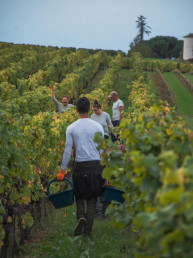
The average vine age is 45 years, with some that are closer to 100 years old. The vineyard is planted to a vine density of 6,600 vines per hectare which is higher than required for the appellation. Oenologist Matthieu Arroyo and his team have started a programme of rejuvenating the average age of vines and maintaining a select few hundred-year-old vines to ensure the unique intensity and structure from these grapes is enhanced by the fruit forward qualities of the younger vines.
In the Winery - In the Chai
With a brand new winery built purely for an eco-friendly and sustainable future, Chateau d’Arche continues to develop their relationship with the climate and earth while furthering the quality of wines. This growth and development are done through building spaces such as a thermo-regulated vat-room made to measure allowing plot-by-plot vinification, with micro-polished steel vats to facilitate cleaning and avoid the use of detergents. Also including an underground barrel storage (Chai) of 300 barrels provides a thermal advantage and allows the filling by gravity.
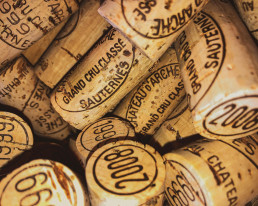
The winemaking process at Château d’Arche involves carefully hand harvesting the ripest grapes affected by noble rot, which are picked in multiple passes through the vineyard, according to vintage conditions, often 4-8 times. While the production of Sauternes is limited to a maximum of 3333 bottles per hectare, which is one of the lowest productions in the world, the requirement of Château d’Arche leads it to produce around 2000 bottles on average per hectare. This represents only 1 to 3 glasses of wine per vine!
In addition, it has been found that Sauternes has health benefits, notably thanks to the polyphenol “resveratrol” synthesized in botrytised grapes resulting from a reaction of the vine against an infection due to the fungus Botrytis Cinerea. An ancient elixir indeed!
The entire crop is barrel-fermented with selected yeasts and aged in one third new French oak barrels for 12 to 18 months, before bottling. There is also a special cuvée of 3,000 bottles called d’Arche-Fafaurie, which is not produced every year; this comes from two hectares of very old vines and is aged for 24 months in 100 per cent new oak. It is interesting to note that Chateau d’Arche is one of the few, if not the only 1855 Classified Growth to use a synthetic cork.
All these laborious and meticulous processes contribute to the development of the truly distinct rich flavours and exceptional quality of Château d’Arche’s sweet wines.
The best vintages of Chateau d’Arche are: 2023, 2022, 2021, 2020, 2019, 2018, 2017, 2016, 2015, 2014, 2013, 2011, 2010, 2009, 2007 and 2005.
The wines of Château d’Arche, which are characterised by their elegance, lightness and delicacy, can literally defy time.
(Website)
A Gift for Your Palate
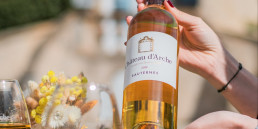
The Wine Insider has some excellent suggestions whereby Chateau d’Arche Sauternes can be enjoyed in its youth. In fact, it is delicious and quite a treat drunk young. Even on release! However, like all great wines, Chateau d’Arche is much better with age. The wine does not reach full maturity until it’s at least 10+ years of age, or even longer in the best vintages. That is when the magic happens!
That may be a tad unrealistic for many wine drinkers. But we have a solution – enter Chateau d’Arche La Perle’! A perfect Sauternes from younger vines designed to be drunk on the “fresh side”. Voilà! So, put its big brother in the cellar to treasure for later and La Perle’ can be enjoyed on any other happy occasion that calls for this vivacious nectar!
Food Matches Made in Heaven
Of course, a fine Chateau d’Arche Sauternes is sweet, but there is so much, incredible, racy acidity, the wine always feels fresh, and never cloying, which makes it quite fun to enjoy young. With all Sauternes, the temperature is more important than decanting.
Chateau d’Arche is best served at 14 degrees Celsius. The cool, almost cellar temperature gives the wine more freshness and lift. The wine will naturally warm in the glass, while it develops more aromatic complexities and fleshes out.
Chateau d’Arche can be served with seafood dishes, especially shellfish, crayfish, crab, and oysters on the half shell. Traditionally Foie gras is the most perfect pairing with its natural sweet, salty and savoury characteristics, however, here in NZ a well-made Duck or chicken liver parfait will send your palate skyrocketing.
Chateau d’Arche can also be paired with roasted chicken, veal, and pork dishes that are either lightly spicy or prepared with a touch of sweetness. Spicy Asian cuisine, raw fish, like sushi or sashimi, and cheeses, both hard and soft also make great pairings with this sublime wine.
Whether savoured as an opulent sweet wine or an elegant aperitif, the Chateau d’Arche wines are a triumph of balance and refinement. Uncork a symphony – a symphony that’s ready to seduce your palate. Bon Appetit!
“Wines don’t have to be rare to be delicious. Or indeed precious”
Hugh Johnson OBE, World Renowned Wine Writer

